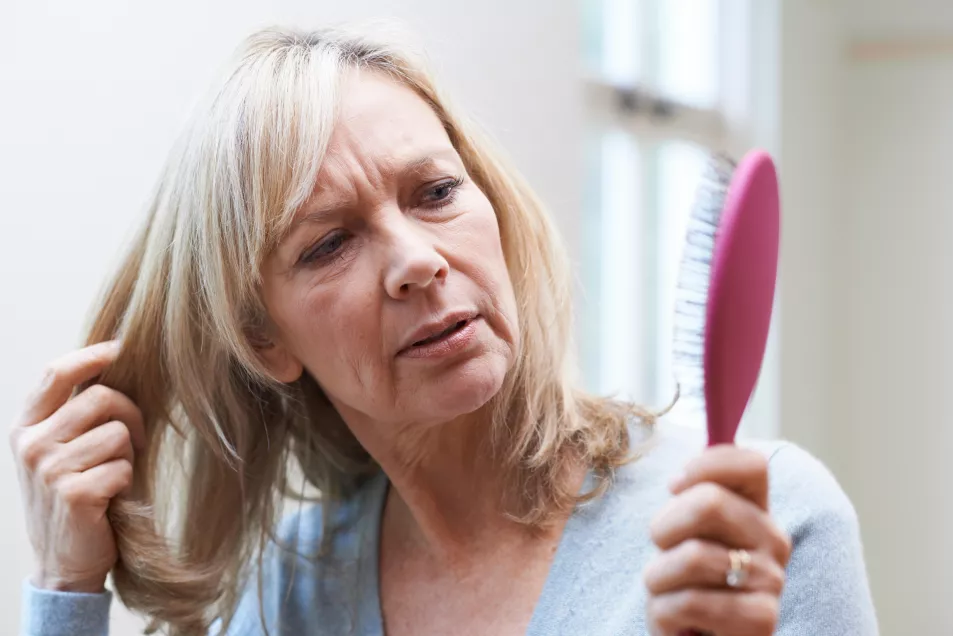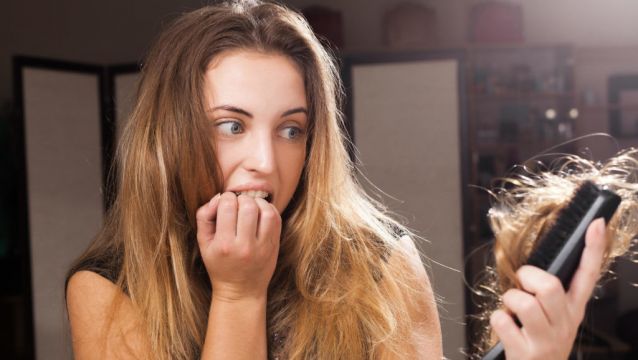Balding and receding hairlines often crop up as a concern amongst men of a certain age, but hair loss can also occur in women too.
The density and quality of our hair often changes as we age, and shedding a certain amount of hair day-to-day is normal. But more prominent hair loss can sometimes be a symptom of a bigger health issue, and it can have a huge impact on confidence and self-esteem.
So, how much hair loss is normal and how can you tell if something is wrong?
Is hair loss normal?

“A certain degree of change to our hair is inevitable as we age,” says Anabel Kingsley, consultant trichologist at Philip Kingsley. “Like any skin, our scalp and hair follicles age. Most women find their hair becomes finer, less dense and less lustrous.
“On average, you will shed around 100 hairs per day,” Kingsley adds. “However, if you see a fluctuation where you are shedding too much hair, or many more hairs than what you consider to be your ‘normal’, then this will usual indicate some internal disturbance or imbalance.”
What causes hair loss in women?
Female hair loss can have a wide range of causes, and it might occur as general thinning in certain areas or throughout the head, or smooth, bald patches developing on the scalp. With the latter, this is usually a condition called alopecia areata, believed to be due to the immune system wrongly attacking hair follicle cells.
“Causes of hair thinning vary, but often can be stress-related, and genetics and changes in hormones also can contribute,” explains Dr Saniyya Mahmood, aesthetic doctor and medical director of Aesthetica Medical Clinic. “Certain medical conditions is also another common reason.”
One such condition which can impact the density and quality of hair is an underactive thyroid.
“An underactive thyroid can lead to the hair feeling more dry and brittle,” says Kingsley. “But this should resolve after starting appropriate medication, although this may take time to become evident.”
Hormonal issues and menopause
Hair loss can also be associated with other types of hormonal changes and imbalances.
Kingsley explains: “A good example of this is polycystic ovary syndrome (PCOS), which can be associated with raised testosterone levels, which in turn can lead to hair thinning in the top region of the scalp, evident as a wider parting and more visible scalp.

“Another example of where hormonal changes can lead to changes in the hair is the menopause, where declining levels of oestrogen can lead to reduced hair density, and also hair that is more dry, due to reduced sebum (oil) production in the hair follicle and the skin in general.”
For some women, this may occur as a sign of perimenopause – the phase leading up to menopause, which may last for years in some cases.
Intimate health specialist Dr Shirin Lakhani of Elite Aesthetics, says: “As women get older, they are more prone to hair-thinning and hair loss but many don’t realise this can start occurring from the age of 25. After menopause, oestrogen no longer counters testosterone and dihydrotestosterone (DHT) can cause a change in the hair follicles on the scalp, becoming smaller in diameter, shorter in length and lighter in colour until they stop producing hair altogether.
“Several other factors that can affect hair loss include strong medications, dietary restrictions, grooming and styling practices, trauma and pregnancy.”
Should I seek help?
Lakhani says: “Hair loss is definitely not just a male issue and women do not need to be ashamed to speak up about it. If you are concerned, please visit a health practitioner or your GP, who will be able to help.”
Mahmood adds: “A professional will be able to determinate the cause of the hair loss via a scalp biopsy and then suggest the best treatment.”
In some cases, your GP may be able to advise on the likely cause of hair loss based on the symptoms and your health history. They can also advise on whether tests would be helpful if any underlying medical issues are suspected.
How is hair loss treated?
This depends on the type of hair loss and what’s causing it. If an underlying medical issue, hormonal imbalance or nutritional deficiency is suspected, addressing these may help resolve it.
There is no cure for alopecia, although sometimes it gets better by itself or comes and goes over time. However, there are certain treatments people may choose to try if suitable, including steroid creams.
What can I do to look after my scalp and hair health?
Showing your hair and scalp some love won’t prevent hair loss in all cases, particularly if there is a medical cause. But it may help keep your tresses feeling their best and keep excess damage at bay. Kingsley shares the following tips…
1. Give your scalp some extra TLC

“It’s your hair support system and the bedrock of your hair follicles. Give it similar care to the skin on your face. Cleanse regularly, tone daily, mask weekly and use SPF on any exposed areas of scalp.”
2. Eat a healthy, balanced diet
“Do not skip breakfast, and include a wide variety of nutrient dense, colourful foods in your meals.”
3. Blow-dry gently

“Use a low to medium heat setting, don’t hold your dryer too close to you hair, and turn it off when your hair is just dry.”
4. Use a good hair brush
“Brushes with long, flexible plastic prongs are best. Boar bristle brushes can scratch both the hair and scalp and cause substantial accumulative damage.”
5. Don’t pull hair back too tightly
“This can cause breakage and, in severe cases, traction alopecia. If a style give you a headache, it’s too tight.”
6. Use hair-friendly hair ties/clips
“Fabric covered, soft scrunchies and light claw clips are good options.”







